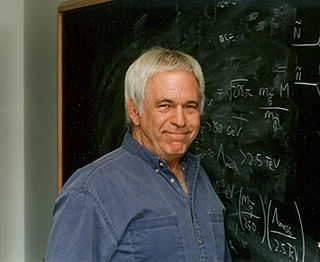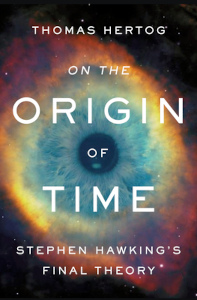
Thomas Hertog is a Belgian cosmologist at KU Leuven university and was a key collaborator of Professor Stephen Hawking. [1]

Thomas Hertog is a Belgian cosmologist at KU Leuven university and was a key collaborator of Professor Stephen Hawking. [1]
Thomas Hertog was born on 27 May 1975. He graduated Summa cum laude from KU Leuven in 1997 with an MSc degree in physics. He obtained his Master's degree at the University of Cambridge in Part III of the Mathematical Tripos and obtained a Ph.D. degree at Cambridge with a thesis on the origins of cosmic expansion under the supervision of Stephen Hawking.
Hertog had the opportunity to conduct research with Stephen Hawking in the field of cosmic inflation, a branch of the Big Bang theory. [2]
He then worked as a researcher at the University of California - Santa Barbara in the United States and the Université de Paris VII in France. He became a fellow at CERN in Geneva in 2005. In October 2011, Hertog was appointed professor at the Institute for Theoretical Physics at KU Leuven through the Odysseus program of the Flemish government. [3] He leads a research group studying the relationship between the Big Bang and string theory, with the idea that concepts like space and time lose their meaning. He also emphasizes Georges Lemaître's insight that the Big Bang is central to Einstein's gravitational waves. Hertog worked in the field of quantum cosmology and string theory with James Hartle and Stephen Hawking. In 2011, after years of research, they came to a new insight by combining the mathematics of quantum cosmology and that of string theory.[ citation needed ] In 2018, he published 'A smooth exit from eternal inflation?' with Stephen Hawking. [4]
Hertog was an important contributor to the development of top-down cosmology. [5] He explains the theory in his 2023 book On the Origin of Time, which Hawking asked him to write just before his death. [6]

The Big Bang was the initiation of the continuing expansion of the universe from a state of high density and temperature. It was first proposed as a physical theory in 1931 by Roman Catholic priest and physicist Georges Lemaître when he suggested the universe emerged from a "primeval atom". Various cosmological models of the Big Bang explain the evolution of the observable universe from the earliest known periods through its subsequent large-scale form. These models offer a comprehensive explanation for a broad range of observed phenomena, including the abundance of light elements, the cosmic microwave background (CMB) radiation, and large-scale structure. The overall uniformity of the universe, known as the flatness problem, is explained through cosmic inflation: a sudden and very rapid expansion of space during the earliest moments. However, physics currently lacks a widely accepted theory of quantum gravity that can successfully model the earliest conditions of the Big Bang.

Physical cosmology is a branch of cosmology concerned with the study of cosmological models. A cosmological model, or simply cosmology, provides a description of the largest-scale structures and dynamics of the universe and allows study of fundamental questions about its origin, structure, evolution, and ultimate fate. Cosmology as a science originated with the Copernican principle, which implies that celestial bodies obey identical physical laws to those on Earth, and Newtonian mechanics, which first allowed those physical laws to be understood.
In physical cosmology, cosmic inflation, cosmological inflation, or just inflation, is a theory of exponential expansion of space in the early universe. The inflationary epoch is believed to have lasted from 10−36 seconds to between 10−33 and 10−32 seconds after the Big Bang. Following the inflationary period, the universe continued to expand, but at a slower rate. The re-acceleration of this slowing expansion due to dark energy began after the universe was already over 7.7 billion years old.

In physics, black hole thermodynamics is the area of study that seeks to reconcile the laws of thermodynamics with the existence of black hole event horizons. As the study of the statistical mechanics of black-body radiation led to the development of the theory of quantum mechanics, the effort to understand the statistical mechanics of black holes has had a deep impact upon the understanding of quantum gravity, leading to the formulation of the holographic principle.
The Big Bounce hypothesis is a cosmological model for the origin of the known universe. It was originally suggested as a phase of the cyclic model or oscillatory universe interpretation of the Big Bang, where the first cosmological event was the result of the collapse of a previous universe. It receded from serious consideration in the early 1980s after inflation theory emerged as a solution to the horizon problem, which had arisen from advances in observations revealing the large-scale structure of the universe.
Brane cosmology refers to several theories in particle physics and cosmology related to string theory, superstring theory and M-theory.
Micro black holes, also called mini black holes or quantum mechanical black holes, are hypothetical tiny black holes, for which quantum mechanical effects play an important role. The concept that black holes may exist that are smaller than stellar mass was introduced in 1971 by Stephen Hawking.

The black hole information paradox is a paradox that appears when the predictions of quantum mechanics and general relativity are combined. The theory of general relativity predicts the existence of black holes that are regions of spacetime from which nothing—not even light—can escape. In the 1970s, Stephen Hawking applied the semiclassical approach of quantum field theory in curved spacetime to such systems and found that an isolated black hole would emit a form of radiation. He also argued that the detailed form of the radiation would be independent of the initial state of the black hole, and depend only on its mass, electric charge and angular momentum.
In theoretical physics, top-down cosmology is a proposal to regard the many possible histories of a given event as having real existence. This idea of multiple histories has been applied to cosmology, in a theoretical interpretation in which the universe has multiple possible cosmologies, and in which reasoning backwards from the current state of the universe to a quantum superposition of possible cosmic histories makes sense. Stephen Hawking has argued that the principles of quantum mechanics forbid a single cosmic history, and has proposed cosmological theories in which the lack of a past boundary condition naturally leads to multiple histories, called the 'no-boundary proposal', the proposed Hartle–Hawking state.

Quantum cosmology is the attempt in theoretical physics to develop a quantum theory of the universe. This approach attempts to answer open questions of classical physical cosmology, particularly those related to the first phases of the universe.
Eternal inflation is a hypothetical inflationary universe model, which is itself an outgrowth or extension of the Big Bang theory.
Igor R. Klebanov is an American theoretical physicist. Since 1989, he has been a faculty member at Princeton University where he is currently a Eugene Higgins Professor of Physics and the director of the Princeton Center for Theoretical Science. In 2016, he was elected to the National Academy of Sciences. Since 2022, he is the director of the Simons Collaboration on Confinement and QCD Strings.

Christopher T. Hill is an American theoretical physicist at the Fermi National Accelerator Laboratory who did undergraduate work in physics at M.I.T., and graduate work at Caltech. Hill's Ph.D. thesis, "Higgs Scalars and the Nonleptonic Weak Interactions" (1977) contains one of the first detailed discussions of the two-Higgs-doublet model and its impact upon weak interactions. His work mainly focuses on new physics that can be probed in laboratory experiments or cosmology.

Mark Trodden is a theoretical cosmologist and particle physicist. He is the Fay R. and Eugene L. Langberg Professor of Physics and Co-Director of the Center for Particle Cosmology at the University of Pennsylvania.
Sergei D. Odintsov is a Russian astrophysicist active in the fields of cosmology, quantum field theory and quantum gravity. Odintsov is an ICREA Research Professor at the Institut de Ciències de l'Espai (Barcelona) since 2003. He also collaborates as group leader at research projects of the Tomsk State Pedagogical University. He is editor-in-chief of Symmetry, and is a member of the editorial boards of Gravitation and Cosmology, International Journal of Geometric Methods in Modern Physics, International Journal of Modern Physics D, Journal of Gravity, Universe, and the Tomsk State Pedagogical University Bulletin. Odintsov also is an advisory panel member of Classical and Quantum Gravity.

Gordon Leon Kane is Victor Weisskopf Distinguished University Professor at the University of Michigan and director emeritus at the Leinweber Center for Theoretical Physics (LCTP), a leading center for the advancement of theoretical physics. He was director of the LCTP from 2005 to 2011 and Victor Weisskopf Collegiate Professor of Physics from 2002 - 2011. He received the Lilienfeld Prize from the American Physical Society in 2012, and the J. J. Sakurai Prize for Theoretical Particle Physics in 2017.
The Bousso bound captures a fundamental relation between quantum information and the geometry of space and time. It appears to be an imprint of a unified theory that combines quantum mechanics with Einstein's general relativity. The study of black hole thermodynamics and the information paradox led to the idea of the holographic principle: the entropy of matter and radiation in a spatial region cannot exceed the Bekenstein–Hawking entropy of the boundary of the region, which is proportional to the boundary area. However, this "spacelike" entropy bound fails in cosmology; for example, it does not hold true in our universe.
Raphael Bousso is a theoretical physicist and cosmologist. He is a professor at the Berkeley Center for Theoretical Physics in the Department of Physics, UC Berkeley. He is known for the Bousso bound on the information content of the universe. With Joseph Polchinski, Bousso proposed the string theory landscape as a solution to the cosmological constant problem.
A. W. Peet is a professor of physics at the University of Toronto. Peet's research interests include string theory as a quantum theory of gravity, quantum field theory and applications of string theory to black holes, gauge theories, cosmology, and the correspondence between anti-de Sitter space and conformal field theories.

On the Origin of Time is a 2023 book by physicist Thomas Hertog about the theories of Stephen Hawking. Hertog is a Belgian cosmologist working at KU Leuven university, who worked extensively with Hawking. He wrote the book at Hawking's request to popularize the top-down cosmological theory that they had developed together.